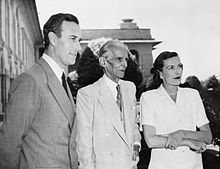User:Cyber.Eyes.2005/Sandbox
My Sandbox...

Naming Dispute Between India and Pakistan
The naming dispute between India and Pakistan in 1947 refers to the contention over the use of the name "India" following the partition of British Raj. This dispute involved key figures such as Lord Mountbatten, the last Viceroy of British Raj, and Muhammad Ali Jinnah, the leader of the Muslim League and the founder of Pakistan. By 1947, the British Raj was going to be divided into two new nation states — Hindustan and Pakistan. Jinnah was initially convinced that no state would use the term India, since it lacked any indigenous pedigree and opposed the use of the name "India" as it would cause confusion. The disagreement had significant implications for national identity and international recognition.
The Abbasid Dynasty of Bahawalpur traces its descent to the sixth Abbasid Caliph of Egypt who In the second half of the 14th century migrated to Sindh.[1]
Located on the other side of the Radcliffe Line from Bikaner and Jaisalmer, Bahawalpur was a seventeen-gun-salute state. It joined the ranks of the princely states under British paramountcy in 1833 after seeking the East India Company's protection against Ranjit Singh, the Sikh ruler of Punjab. Its sovereign in 1947 was Nawab Sadiq Muhammad Khan V, sixtieth in a line of descent that traced its origins to Al Abbas Ibn Abdul al Muttalib, an uncle of the Prophet Muhammad, through the Abbasid caliphs of Cairo and Baghdad. Bahawalpur was founded by Nawab Mohammad Bahawal Khan II in 1802 after the fall of the Durrani dynasty of Afghanistan that had occupied the region. Once stretching as far north as the Sutlej and Indus rivers, Bahawalpur had strategic importance and had been used as a base by the British for their campaigns in Baluchistan, Sind and Afghanistan.
Credit for turning a feudal backwater into a modern state with grand public buildings, canals, railways, and an efficient administration goes to Sadiq Muhammad Khan IV, who ascended the gaddi at the age of four and was invested with full powers at the age of eighteen in 1879. Unlike his traditionally dressed father, Sadiq Muhammad V belonged to the 'breeches and boots and flannels for cricket' school of ruler and prided himself on his European tastes, though he was also fanatical about his ancestry and wore a fez to emphasize his Abbasid roots.[2]
- ↑ Jafri, Saiyid Zaheer Husain; Reifeld, Helmut (2006). The Islamic Path: Sufism, Society, and Politics in India. Rainbow Publishers. ISBN 978-81-86962-85-5.
- ↑ Zubrzycki, John (2024-02). Dethroned: The Downfall of India's Princely States. Oxford University Press. ISBN 978-1-80526-053-0.
{{cite book}}: Check date values in:|date=(help)

